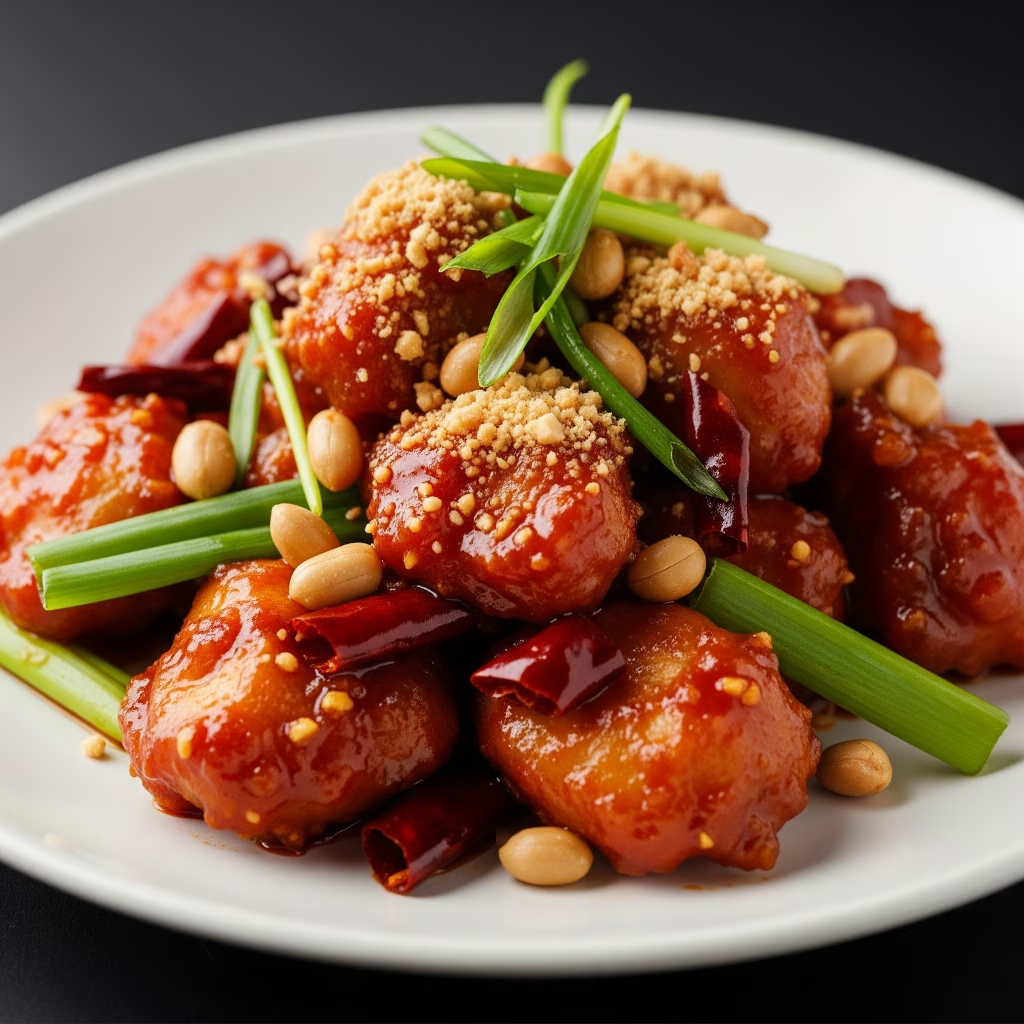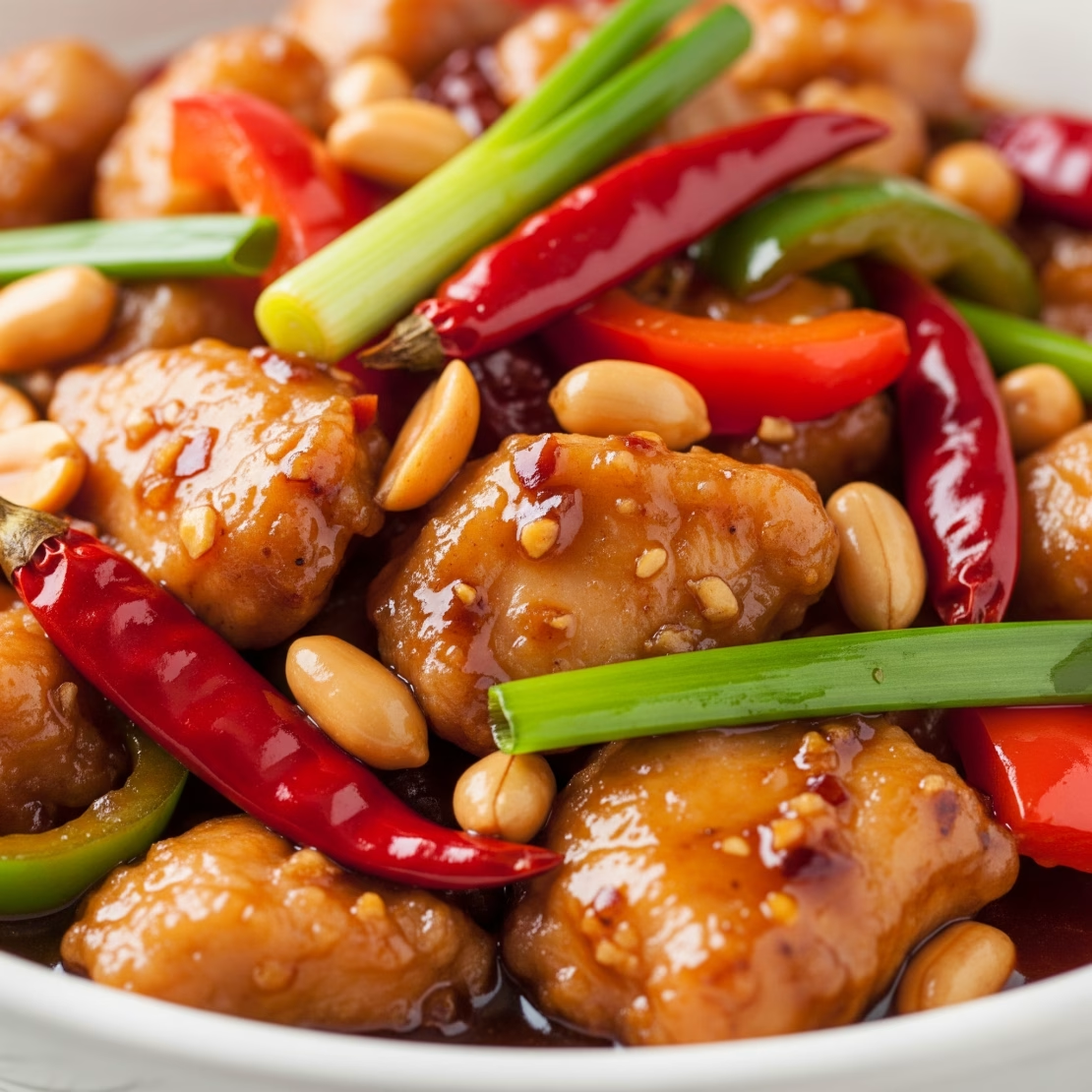Chinese Kung Pao Chicken is a globally renowned stir-fry dish that hails from the Sichuan province of China. Characterized by its perfect balance of spicy, sweet, sour, and savory flavors, this dish is a textural and sensory delight.
Made with tender chunks of marinated chicken, crunchy peanuts, crisp vegetables, and aromatic dried chilies, Kung Pao Chicken delivers the signature numbing heat of Sichuan peppercorns. Whether served at an upscale restaurant or made at home, this dish represents the harmony of traditional Chinese cooking. With bold flavors and just the right kick, Kung Pao Chicken continues to win hearts across cultures and continents.
Table of Contents
Ingredients
For the Chicken Marinade:
- 500g (1.1 lbs) boneless, skinless chicken thighs or breasts, diced into 1-inch pieces
- 1 tbsp soy sauce
- 1 tsp Shaoxing wine (or dry sherry)
- 1 tsp cornstarch
For the Sauce:
- 1½ tbsp light soy sauce
- 1 tbsp dark soy sauce
- 1 tbsp Chinkiang vinegar (or balsamic vinegar)
- 1 tbsp sugar
- 1 tsp hoisin sauce (optional)
- 2 tsp cornstarch
- ¼ cup water
For Stir-Frying:
- 2 tbsp cooking oil (peanut or vegetable oil)
- 8–10 dried red chilies, cut into halves and seeds removed
- 1 tsp Sichuan peppercorns (lightly toasted and crushed)
- 3 garlic cloves, finely chopped
- 1-inch piece ginger, minced
- 4–5 spring onions (white and green parts separated), chopped
- ½ bell pepper, diced (optional for color and crunch)
- ½ cup roasted unsalted peanuts
Serves
Serves: 3–4 people
Prep Time: 20 minutes
Marinating Time: 15–30 minutes
Cook Time: 15 minutes
Total Time: 45 minutes
Step-by-Step Instructions
Step 1: Marinate the Chicken
- In a bowl, combine diced chicken with soy sauce, Shaoxing wine, and cornstarch.
- Mix well and let it marinate for 15–30 minutes. This enhances flavor and keeps the chicken tender when stir-fried.
Step 2: Prepare the Sauce
- In a small bowl, whisk together all the sauce ingredients: light soy sauce, dark soy sauce, Chinkiang vinegar, sugar, hoisin sauce (if using), cornstarch, and water.
- Set aside for quick use during stir-frying.
Step 3: Stir-Fry the Aromatics
- Heat oil in a wok over medium-high heat.
- Add the dried chilies and toast for about 10–15 seconds until fragrant, but not burnt.
- Add the Sichuan peppercorns and stir quickly.
- Add chopped garlic, ginger, and the white parts of the spring onion. Stir-fry for 30 seconds.
Step 4: Cook the Chicken
- Add the marinated chicken to the wok.
- Stir-fry for 3–4 minutes or until the chicken is browned and cooked through.
Step 5: Add Sauce and Finish
- Pour in the sauce and let it bubble for 1–2 minutes, stirring until it thickens and evenly coats the chicken.
- Toss in bell peppers (if using), roasted peanuts, and green parts of the spring onions.
- Stir everything well and remove from heat.

Serving Suggestions
- Serve with Jasmine or Steamed Rice: The savory-spicy sauce pairs beautifully with plain white rice.
- Fried Rice Base: For a heartier meal, serve over egg fried rice or garlic fried rice.
- Lettuce Wraps: Serve in crisp lettuce cups for a low-carb option.
- Noodles: Stir the Kung Pao Chicken into lo mein or egg noodles for a flavorful variation.
Tips for Perfect Kung Pao Chicken
- Use Dried Red Chilies with Care: Remove seeds to adjust heat level. Toasting them enhances flavor.
- Sichuan Peppercorns Are Essential: They give the dish its signature numbing-spicy effect.
- High Heat is Key: Stir-fry over high heat to sear and preserve texture.
- Peanuts Go in Last: Add at the end to maintain their crunch.
- Use a Carbon Steel Wok: It ensures even heat and authentic stir-fry flavor.
Healthier Alternatives
- Chicken Breast Instead of Thighs: For lower fat content.
- Reduce Sugar: Cut sugar to half or substitute with honey or stevia.
- Skip the Peanuts: Use almonds or skip entirely if allergic.
- Low-Sodium Soy Sauce: Helps control salt levels without sacrificing flavor.
- Stir-Fry with Less Oil: Use a non-stick pan and reduce oil to 1 tbsp.
Creative Variations
- Kung Pao Tofu: Swap chicken with extra-firm tofu for a vegetarian version.
- Kung Pao Shrimp: Quick-cooking shrimp works wonderfully in this flavor profile.
- Add Vegetables: Broccoli, snow peas, or zucchini add color and nutrition.
- Cashew Chicken Twist: Replace peanuts with cashews for a luxurious touch.
- Pineapple Kung Pao: A sweet-and-spicy variation that adds tropical brightness.
Common Mistakes to Avoid
- Overcooking the Chicken: Especially if using breast meat, don’t overdo it or it’ll dry out.
- Burning the Chilies: Burnt chilies become bitter—toast lightly.
- Using Regular Black Pepper: Only Sichuan peppercorns give the numbing effect.
- Sauce Too Thin or Thick: Stick to correct cornstarch ratio for perfect consistency.
- Overloading the Wok: Crowding reduces heat, causing steaming instead of stir-frying.
History of Chinese Kung Pao Chicken
1. Origins in Sichuan Cuisine
Kung Pao Chicken (宫保鸡丁, Gōng Bǎo Jī Dīng) originated in the Sichuan province of China during the Qing Dynasty. It was named after Ding Baozhen, a governor of Sichuan, who held the title “Gong Bao” or “Palace Guardian.” He loved this chicken dish made with peanuts, chilies, and sauce, which eventually became associated with his name. The original version embraced bold Sichuan flavors—spicy, numbing, savory—hallmarks of the region’s cuisine.

2. Evolution Across Regions and Borders
While traditionally very spicy and oily, the dish adapted over time. In northern China, the recipe is often sweeter and less spicy, sometimes even served without the Sichuan peppercorns. In the West, Kung Pao Chicken was introduced through Chinese-American restaurants, evolving further to suit local palates—sweeter, less spicy, and often served with bell peppers and carrots.
3. A Global Favorite with Local Twists
Today, Kung Pao Chicken is found worldwide with variations—from Thai versions using fish sauce to American renditions loaded with sugar and cornstarch. Despite the variations, the essence of the dish remains: a celebration of texture, heat, and balance. In Sichuan homes, it’s still a weekday staple and a beloved icon of regional cuisine.
FAQs About Chinese Kung Pao Chicken
1. What does “Kung Pao” mean?
“Kung Pao” (Gong Bao) is a title given to a Qing Dynasty official—Ding Baozhen—who is credited with inspiring the dish.
2. Is Kung Pao Chicken always spicy?
Traditionally yes, but spice levels can be adjusted. Remove chili seeds or reduce the number of chilies.
3. What’s the difference between Kung Pao and General Tso’s Chicken?
Kung Pao is stir-fried with peanuts and chilies; General Tso’s is usually deep-fried and sweet with a sticky sauce.
4. Can I use cashews instead of peanuts?
Yes, cashews make a delicious alternative with a richer, buttery flavor.
5. What does Sichuan pepper taste like?
It’s citrusy and causes a tingling-numbing sensation on the tongue—distinct from regular pepper.
6. Is Kung Pao Chicken gluten-free?
It can be if you use gluten-free soy sauce (like tamari) and check other sauces for wheat.
7. Can I make it vegetarian?
Yes! Use tofu, mushrooms, or tempeh as substitutes.
8. Why is my sauce too runny?
You may need to add more cornstarch or reduce the sauce longer over high heat.
9. What kind of chilies are best?
Use dried Chinese Tien Tsin or Facing Heaven chilies for authenticity. Thai dried chilies also work.
10. Is it okay to prep in advance?
Absolutely. You can marinate the chicken and prep the sauce and veggies a day ahead.
Chinese Kung Pao Chicken is a masterpiece of balance—fiery yet flavorful, savory with a touch of sweet, crunchy with a juicy bite. Whether you’re seeking a fiery weeknight meal or impressing guests with authentic Chinese cuisine, this dish delivers satisfaction in every spicy, nutty bite. Mastering Kung Pao Chicken also means embracing the core techniques of stir-frying, sauce balancing, and working with bold ingredients like Sichuan peppercorns and dried chilies. Serve it hot, serve it proud—because this isn’t just food; it’s flavor on fire.


